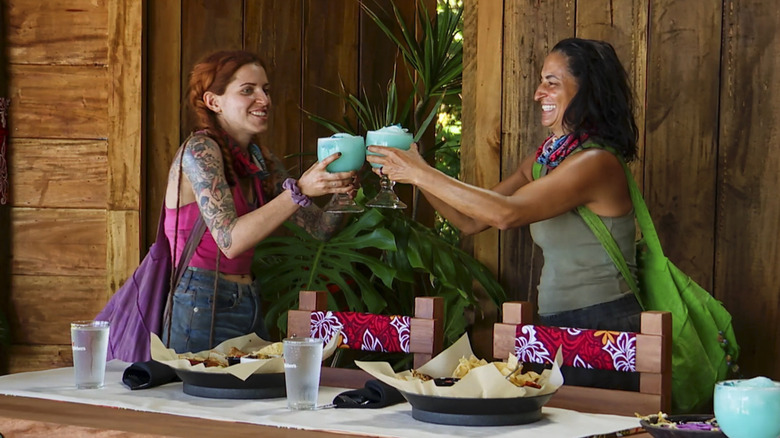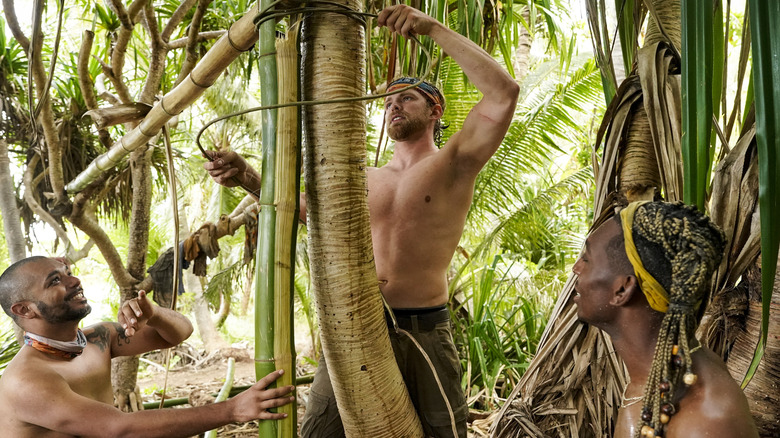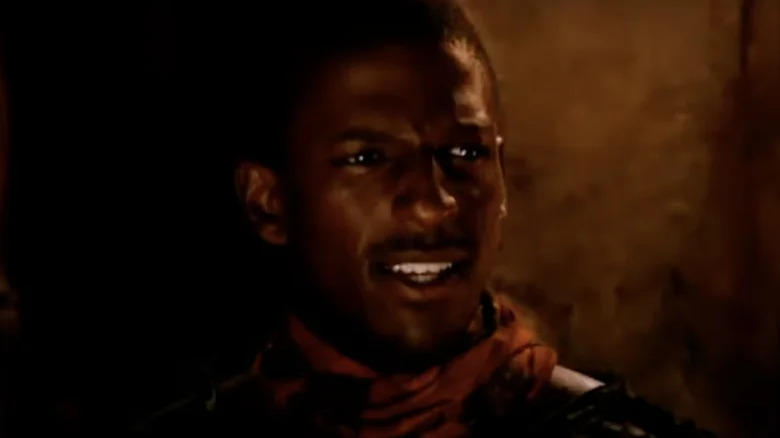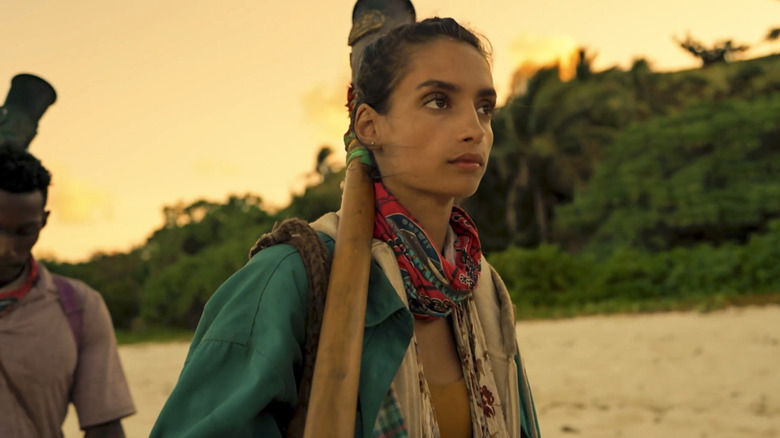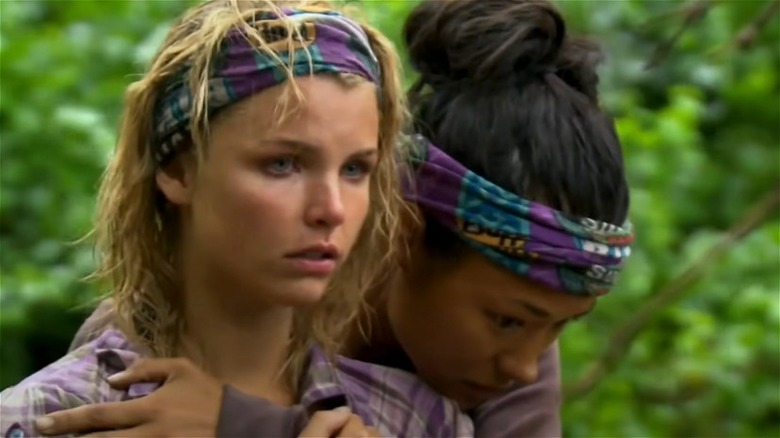Things You Didn't Realize Survivor Contestants Have Access To
In case you've never seen the show, the whole point of "Survivor" is that its contestants don't have access to much. Each tribe may receive a canteen or old pot, but beyond that, they're largely left to fend for themselves. Or are they? This is reality TV, after all. It's no great secret that reality programs are usually more scripted than they lead viewers to believe. As the seasons piled on and viewers noticed things like a lack of body hair growth, glowing white teeth in the outback, and endless amounts of drinking water without contestants having to boil it, it's only fair to wonder what exactly they're not showing.
The truth is, "Survivor" has either done an amazing job maintaining the competitive integrity of the show or excelling at paying off previous cast members for silence. 46 seasons (and counting!) of contestants confirm that the closest thing they ever got to a toothbrush was a stick of bamboo dipped in ash. There are certainly no air mattresses and gas-powered camping stoves tucked away for lounging between takes.
Still, don't contestants need certain things that never make it on camera, like tampons? A few surprising items are accessible for players, hidden from camera 2's sight. Here are the off-camera assets "Survivor" players rely on to make it home in one piece.
A stash of medical supplies
While "Survivor" seeks to push its players to their limits and simulate real survival situations, the crew also wants all players to survive filming. To help them do that, the show provides players with an off-camera storage container packed full of survival equipment. The box contains essentials like contact lens solution, sunscreen, and medications. There are strict rules around using this medical equipment, mainly to protect the legitimacy of the show. Because producers don't want to film competitors using things not native to the location, only one person can access the box at a time, and contestants are not allowed to speak to each other while applying sunscreen.
In addition to life-saving equipment, this box also provides birth control and feminine hygiene products like tampons and condoms. Previous contestant Janet Koth was quite amused that the show gave an all-women tribe plenty of condoms, but her team still found ways to use them. Fellow tribe member Christy Smith used the condoms to protect her blistered feet while on jaguar watch. Somehow, that magnificent footage didn't make it to air, but you have to wonder what would have happened if Christy had actually bumped into a jaguar while wearing two lubricated socks.
Survival training
No, "Survivor" producers are not only picking participants who already know how to start a fire with flint and wrap palm fronds into shelters. The reason both tribes are usually capable of doing the bare minimum to survive in the harsh conditions is because players receive four days of intense wilderness training."Survivor" producers told People that these sessions provide a crash course in survival and "general overall jungle safety."
This session is called Survival School, and it typically features essential life-saving tips that are relevant to the season's location. Behind-the-scenes Instagram shots from Entertainment Weekly's Editorial Director Dalton Ross show Survival School before "Survivor: Cook Islands." Contestants were taught by island natives how to weave palm fronds and build shelters. They even taught the cast which local flora, fauna, and animals were edible. "Survivor: The Amazon" contestant Daniel Lue felt like the competition actually started during these training sessions, as he explained to Entertainment Weekly. Although contestants weren't allowed to speak to each other during the training, everyone was sizing up the competition through non-verbal cues and forming alliances that would eventually influence the show.
Clean drinking water
Early seasons of "Survivor" required the tribes to find their own potable water. Before they could start a fire and properly purify water, contestants had to choose between dehydration or drinking water from murky sources, which led to a whole host of complications. A previous contestant, Eliza Orlins, told The Ringer that she contracted a parasite called giardia in Vanuatu. Season 3 featured footage of tribes taking drinking water and doing laundry from an elephant's toilet,Resulting in several players getting sick from the drinking water. We even saw Oston Taylor quit the show in Season 7 after succumbing to extreme dehydration.
At some point, the production team must have quietly conceded that providing contestants with potable water makes for a better show. At the very least, it surely saved them thousands of dollars in medical expenses. An unnamed cameraman revealed in a Reddit AMA that for the last 13 years, each tribe has had access to a well of drinkable water that gets replenished as needed. Imagine being the person who joined the show and had to drink from an elephant's bathroom, only to find out later that contestants got to enjoy the tropical fruits of Fiji with an unlimited supply of drinkable water.
That doesn't mean it's all sunshine and fresh mountain spring water. Legendary competitor Tyson Apostol explained to Insider that the sitting water gets dirtier as the contest wears on. By day 39, he never wanted "to drink water again."
Rides to Tribal Council
While most seasons of "Survivor" feature B-rolls of tribe members gathering up their belongings, waving flags, and marching along deserted shorelines to Tribal Council, the reality is a bit less "Castaway" and a bit more "24." According to Today journalist Andy Dehnart, who spent a week on the set of "Survivor: Gabon," contestants are whisked towards Council and challenges in vehicles with covered windows, so players cannot see where they are going. During this transport, no one is allowed to speak to each other, as the production crew doesn't want any juicy soundbites leaking out while the cameras aren't rolling. Footage of a backstabbing in the backseat of a minivan just wouldn't fit in with the rest of the show.
To maintain the impression, contestants are told to line up and march down the beach as if they are setting off for the Tribal Council, but they are actually just walking back and forth in circles. Sometimes, players are taken to Council in boats rather than overland vehicles, but they have not walked to their destinations since the show's early seasons. This change ensures no strategy talk is missed by the camera crews during the walk, but it also robs us of beautiful footage of players trying to navigate ants, snakes, and rough jungle pathways with a voiceover of Jeff lecturing the players on being all talk and no action.
Psychologists
We've seen the medical staff make appearances on "Survivor," typically during the show's most frightening moments. First responders helped Kourtney Moon when she fractured her wrist, rescued Michael Skupin when he fell into a fire, and breathed life back into Russell Swan when he fainted during an immunity challenge. As of this writing, there have been 19 medical evacuations over the show's 46-season run. While all contestants' physical wounds healed eventually, mental scars can be more difficult to recover from.
What we don't see on screen are the mental health professionals who help the contestants who aren't taken away in medical evac helicopters. Jeff Probst himself said on his "On Fire" podcast that "Survivor" has a mental health staff alongside their medical team who are ready to step in at any sign of real trouble. These psychologists have plenty of work on their hands, traveling with the game and maintaining communication with players following their appearance on the show.
Past contestant Matt Bischoff said in an interview with Entertainment Weekly, "Pretty much every 'Survivor' [player] I have ever met talks about the woulda coulda shoulda scenarios that will haunt you forever." Former participants have shared that they receive wellness calls from "Survivor" psychologists to help them work through the transition back to normal life, as well as walk them through things like the inevitable self-esteem issues that come with such high-profile failures.
